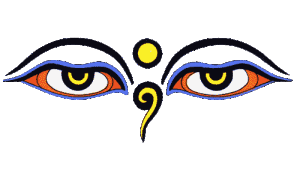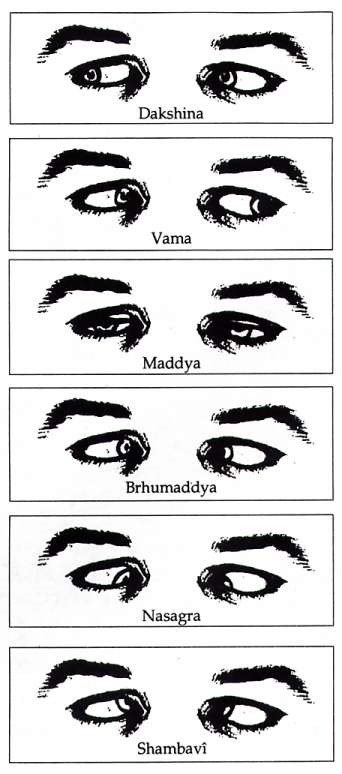Drishti – Focused Gaze in Yoga

Control of drishti, or gaze, has been taught in Yoga for thousands of years. On a simple level, drishti uses a specific gazing direction for the eyes to control attention. Focusing gaze helps in focusing mind. In every asana in yoga, students are taught to direct their gaze to one of nine specific points, but the full meaning of drishti isn’t limited to its value in asana.
In Sanskrit, drishti means gaze; it can also mean a vision, a point of view, or intelligence and wisdom. The use of drishti in asana serves both as a training technique and as a metaphor for focusing consciousness toward a vision of oneness. Drishti organizes our perceptual apparatus to recognize and overcome the limits of ‘normal’ vision. One of the main purposes of yoga is to bring the consciousness to one point so that it isn’t constantly wandering from one thing to another. In every posture of the yoga series there is a drishti, or gaze, so that the mind remains focused and concentrated. A drishti encourages an inward looking attitude and discourages students from looking around the room or being distracted by non-yogic thoughts.
Incorporating drishtis into every posture is an advanced practice. Students usually master co-ordinated breath and movement (vinyasa) first and then gradually incorporate more bandha and drishti work into their practice. Sometimes in meditation and pranayama practices the eyes are held half-open and the gaze is turned up toward the third eye or the tip of the nose. In the Bhagavad Gita (VI.13), Krishna instructs Arjuna, “One should hold one’s body and head erect in a straight line and stare steadily at the tip of the nose.” When using the inner gaze, sometimes called Antaric Drishti, the eyelids are closed and the gaze is directed in and up toward the light of the third eye. As Iyengar says, “The closure of the eyes directs the sadhaka (practitioner) to meditate upon Him who is verily the eye of the eye… and the life of life.”
Throughout the history of yoga, clear, true perception has been both the practice and goal of yoga. In the Bhagavad Gita, Lord Krishna tells Arjuna, “You are not able to behold me with your own eyes; I give thee the divine eye, behold my Lordly yoga” (11.8). In Yoga Sutras, the classic exposition of yoga, Patanjali points out that in viewing the world, we tend not to see reality clearly, but instead get deluded by the error of false perception. This basic misidentification is called avidya (ignorance), and its counterpart, vidya, is our true identity. In Chapter II, verse 6, he says that we confuse the act of seeing with the true perceiver: purusha, the Self. He continues, in verse 17, to say that this confusion about the true relationship between the act of seeing, the object seen, and the identity of the Seer is the root cause of suffering. His cure for this suffering is to look correctly into the world around us.

The correct use of tristhana – breath, bandha and drishti in yoga practice is said to bring us closer to reality and unleash the power of the five elements:
- The element of earth is activated by moola bandha, producing foundation, stability and strength.
- The element of water is found in the fluidity of flowing posture work, or vinyasa, and in the sweat produced by the practice.
- The element of air is linked to by the continuous and uninterrupted flow of ujjayi breath in and out of the body and the feeling of lightness created by the application of bandhas.
- The element of fire is found by connecting to the heat of the practice, particularly at manipura chakra and throughout the body.
- The element of ether or space is found during the postures as students seek to open up the body and find new levels of stretch and flexibility.
Yoga brings about transformation on a physical, emotional, mental and energetic level. When the above elements are incorporated into a correct practice, the process of positive change starts. The positive transformation of the body and mind by yoga is seen as the fruit of practice and a reward for working with dedication and discipline at this demanding system of asana practice.
Drishti, or focused gaze, is a means for developing concentrated intention. It relates to the fifth limb of yoga (pratyahara) concerning sense withdrawal, as well as the sixth limb (dharana) relating to concentration.
Each yoga asana is associated with a particular dṛiṣhṭi. There are nine drishtis (when you count both Parshva Dṛiṣhṭis, left and right sides, as one). The practice of drishti develops concentration—and teaches you to see the world as it really is.
Eyes are the doors which connect the inside mind to the outside world. If the eyes are totally fixed, the mind really stops; it cannot wander. The eyes are the most delicate. That is why they can be more tense than any other part, and with the eyes in tension, the whole mind is tense. The eyes are just doors to the mind. We are predominantly visual creatures. Where our eyes are directed, our attention follows. Our attention is the most valuable thing we have, and the visible world can be an addictive, over-stimulating, and spiritually debilitating lure. When we get caught up in the outer appearance of things, our prana (vitality) flows out and gets dissipated. Allowing the eyes to wander creates distractions that lead us further away from focus.
By controlling and directing the focus of eyes, and then of attention, we can control the focus of our mind.
Besides its use in asana, drishti is applied in other yogic practices. In the kriya of trataka, the eyes are held open until tears flow. This technique not only gives the eyes a wash but also challenges the student to practice overriding unconscious urges – in this case, the urge to blink.
Our eyes can only see objects in front of us that reflect the visible spectrum of light, but yogis seek to view an inner reality not normally visible. With practice, we become aware of how our brains let us see only what we want to see. Often our opinions, prejudices, and habits prevent us from seeing the reality. Drishti is a technique for seeing correctly the world around us. Used in this way, it becomes a technique for removing the ignorance that obscures this true vision, a technique that allows us to see oneness in everything.

Nine Types of Drishti
Angusthamadhye
For Anguṣṭhamadhye drishṭi, meaning ‘to the middle of the thumb, the practitioner looks to the thumb.
Examples of asanas which employ Aṅguṣṭhamadhye as their dṛiṣhṭi can be found in the Surya Namaskara vinyasas.
Bhrumadhye
The Bhrumadhye drishṭi, meaning ‘to the middle of the eyebrows/brow, has the gaze set at the ‘third eye’, which is right between the eyebrows. In order to do this, the eyes are closed half way. This purportedly stimulates the olfactory and optic nerves, consequently awakening the autonomic and central nervous systems. It soothes the cranial nerves and aids concentration, and helps awaken kundalini shakti.
It is advised that caution be taken as prolonged or incorrect practice may cause problems for the eye muscles or nervous system. Initial practice is often done for only seconds at a time, but is gradually increased.
An example of a vinyasa which includes the Bhrumadhye dṛiṣhṭi in its practice is Surya Namaskara.
Nasagre
The Nasagre drishṭi, meaning ‘to the tip of the nose’, has the eyes fixed on the tip of the nose. Purportedly strengthens the eye muscles.
Keep the body pose firm, in Padmasana if possible, and centre the gaze at the tip of the nose. In the later stages, it can be practised even with the closed eyes. The process of gazing at the tip of the nose without fluttering the eyelids, helps to achieve the concentration of the mind.
While learning it can be performed even for a minute or two at a stretch. Later, it may be practised for longer duration.
This helps achieve the concentration of the brain fast and with ease.
Hastagrahe
The Hastagrahe drishti, generally meaning ‘the taking of the hand’ or ‘the putting of the hand to’, or (in the context of dṛiṣhṭi) ‘to the tips of the hand’, involves looking at the (usually extended) tips or palm of the hand.
Utthita Trikonasana, and its twisted partner Parivrtta Trikonasana are two examples of asanas which use Hastagraha dṛiṣhṭi.
Parshva
Parshva drishti, involves looking to the left or right side.
Urdhva
Urdhva drishti has the eyes pointing upwards, to the sky.
Nabhichakre
The navel is the center of focus for the Nabhichakre drishti, meaning ‘to the (magical) navel-circle’.
Adho-Mukha-Shvanasana uses the Nabhichakre drishti.
Padayoragre
Padayoragre drishti, meaning ‘to the tips of the feet’, is gazing to the toes.
Basis of Drishti
The source of drishtis in yoga is limbs 5 and 6 from the eight limbs of yoga. The 5th limb of yoga pratyahara concerns sense withdrawal. To avoid the delusion and suffering caused by preoccupation with sense objects as described in the Maitri Upanishad, sense withdrawal is practiced in order to help the practitioner become ‘centered’. According to tantric philosophy, keeping ‘centered’ madhya will eventually suspend the mind and prana, allowing recognition of bhairava, or device consciousness.
The sixth limb of yoga dharana (concentration), includes maintaining drishti during yoga practice in order to ensure dhyana (meditation) will occur.
Variation Between Styles
There may be differences between different styles regarding how drishti is practiced and which ones are used for specific asanas, however drishti is a primary part of Hatha Yoga, Gyana Yoga, Bhakti Yoga, and Raja Yoga traditions.
In Practice
As with many Yogic techniques, with drishti there is a danger of mistaking the technique for the goal. Dedicate your use of the body (including the eyes) to transcend your identification with it. So when you look at an object during your practice, don’t focus on it with a hard gaze. Instead, use a soft gaze, looking through it toward a vision of cosmic unity. Soften your focus to send your attention beyond outer appearance to inner essence.
In general, practitioners should use the various bahya (external) gazing points during more externally oriented yoga practices, including asanas, kriyas (cleansing practices), seva (the service work of karma yoga), and bhakti (devotion); use the antaric (internal) gaze to enhance contemplative and meditative practices. If you find yourself closing the eyes during any practice and focusing on the dramas or perplexities of life instead of being able to maintain a neutral, detached focus, re-establish an outer gaze. On the other hand, if the outer gaze becomes a distraction to your concentration, perhaps an inner-directed correction is necessary.
Constant application of drishti develops ekagrata, single-pointed focus. When you restrict your visual focus to one point, your attention doesn’t wander from object to object. Moreover, it becomes much easier for you to notice the internal wanderings of your attention and maintain balance in mind as well as body.
Drishti Gives The True View
A Yogi uses a vision comprised of viveka (discrimination between ‘real view’ and ‘unreal, apparent view’) and vairagya (detachment from a mistaken identification with either the instrument of seeing or that which is seen). Charged with yogic vision, we see our true Self. As we gaze at others, we perceive our own form, which is Love itself. We see their suffering as our own; our heart is filled with compassion for the struggles of all the souls. The yogic gaze emerges from an intense desire to achieve the highest goal of unitive consciousness, rather than from egoistic motives that create separation, limitation, judgment, and suffering.
Like all yogic practices, drishti uses the gifts of a human body and mind as a starting place for connecting with our full potential. When we clear our vision of the veils of habits, opinions, ideas, and their false projections about what is real and what is false, we gaze beyond outer differences toward the absolute Truth of internal oneness.
To delve deeper into this important topic in Yoga, please check different courses at SAVY.
Dr Jitender K Sahdev
President and Director of Teaching
Please contact us to learn more about Yoga. We would love to hear any suggestions or comments that you might have. Space is limited in courses and participation will be on a first-come-first-served basis. So, respond early to participate in this exciting, life-transforming Yoga experience.


You must be logged in to post a comment.